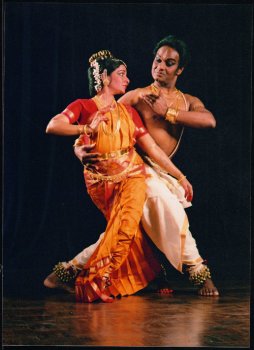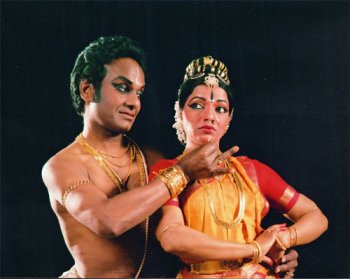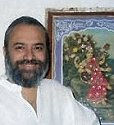
|   |

|   |
Raja and Radha Reddy - Ashish Mohan Khokar, Bangalore e-mail: mr.dancehistory@gmail.com September 8, 2011 In the history of Kuchipudi, one dancing couple broke from melam tradition and created a synergetic union as a couple which was never done with such aplomb and effect before. They started a trend of dancing couples in Kuchipudi and others have tried to clone that without much success. As homage to this very exceptional Kuchipudi couple, in the current issue of attendance 2011 (www.attendance-india.com), they and other such legendary dance couples were featured first. This is an interview based feature. Raja Reddy: I was born on the 6th of October 1943, in Narsapur, on the border of Maharashtra. I hailed from an agricultural Family. Radha was born on the 15th of February 1952 in Gottalgaon, Andhra Pradesh. It was our great and good luck that both of us learnt from Vedantam Prahlada Sarma. Ours was a child marriage. When Radha grew up (turned 13-14 years old), she wanted to dance and so did I. So we went to Hyderabad. I took her to Vedantam Prahlada Sarma for many earlier gurus had rejected me as I was dark, a boy and came from the Reddy (agricultural) family. We went to him also as Telengana did not have brahminical traditions as the Kuchipudi region. So I wanted to acquire the finer nuances of dance. My father, steeped into agricultural ways would whip me with a hunter as I wanted to dance. Once the crops were harvested, I liked to travel with the bhagavatam troupes. For going to Hyderabad, I had to sell my t-shirt as I had no money. Radha Reddy: My father's name was Raja too! And my nana was called Rama. My family often felt that Raja would not be able to even feed me. Raja Reddy: Our guru's style is all about perfection. Perfecting the fundamentals is essential. Elements like hand stretch, chowkam etc are very important. Ashish Khokar: Kuchipudi mellam to solo format process - how did that come about? Raja Reddy: That came about as it was becoming increasingly difficult to maintain by dance parties and groups. Our guru, Vedantam Prahlada Sarma asked us to learn from Vedantam Lakshminarayana Sastry. Ashish Khokar: Were films an influence then in Madras or Hyderabad? Radha Reddy: No, not so much then, though Vedantam Raghavayya and Chinta went into composing for films.  Raja Reddy: Kapila-ji (Vatsyayan) is correct in writing that there was no seriousness in Kuchipudi. Though it is a mellam art, it had a village-like approach. So in the years 1964-65, we went to learn from Vedantam Prahlada Sarma. We would cook for him, learn from him when he taught. He taught us Ganesha vandana, Shiva vandana, veera rasa etc and bhavam too. He said that movements should also be full of veera rasa. We would also practice the same way. Rhythm was very important. According to our guru, the items that were set in a slow tempo were meant to be done in a slow tempo. Our guru inserted rhythmic jatis even in padams. He learnt from Vedantam Lakshminarayana Sastry, so his vision was vast. The stomping of feet is very important in Kuchipudi. Now it is totally gone. Just like ending on sama is integral to Kathak, so is in Kuchipudi the strength of footwork and clarity of beating/stomping of feet. Now that aspect is diluted and missing. Our guru would say, "When men dance, they should do it like men, and women as women." His idea was that Shastric traditions were important, gender was not. In 1966, in Elluru, I was spotted by Maya Rao-ji during a performance. I was then with the Physical Technical Education Department. Dance was a part of it. One thing led to another and in December 1966, we were called to Delhi for three years. We learnt Kathak and got our fodder from dance-dramas. Shakti Bhatnagar and Ranjana Gauhar used to take part in dance-dramas those days. Our first major show was in the youth festival planned by Mohan Khokar for the Sangeet Natak Akademi. Durga Lal and other dancers were performing in that festival. Radha was also selected to perform in that (I just tagged along with her). The festival was held at Sapru House. Mohan Khokar let me perform with Radha. That is how our 'jodi' was born, thanks to Mohan khokar and then Dr. Karan Singh. Mohan Khokar was a very deep and detailed man. Once we were singing/ reciting our jatiswaram bols and he said, "Don't sing, just dance." His scholarship was deep as he saw and took notes and photographs firsthand. He travelled to villages in Andhra (with Kamalini) and often documented dance. We have a great deal of respect for him. Those days and such people are gone. Now it is all about public relations and writers who can be told what to write. Radha Reddy: Today, gurus are afraid of their shishyas who do not even offer pranams to their gurus. Raja Reddy: Many people learnt a smattering of Kuchipudi in coastal Andhra (Vizag, Guntur etc) and now they teach in the USA and make money. So art is all about money now. Our guru did not even know what they were paid then. Kausalya Reddy: Those who have gone to USA are the IT people, and dance for them is extra income. Raja Reddy: They even dance to film songs. Kausalya Reddy: One does not find dedicated gurus or shishyas now. Raja Reddy: On the 13th of January 1970, we performed at The AIFACS. We received very good press reviews from MN Srinivasan, The Patriot and Subbudu wrote in The Statesman, 'Andhra dancers storm Delhi.' Kausalya Reddy: We still have that review.  Raja Reddy: Then Indrani Rehman saw us perform. She came home and said that she wanted us as dancers in her group. So for two years we performed as part of her group. Dr. Karan Singh loved our presentations. He insisted that we do not leave but stay in Delhi. He said, "Don't go, you are in the capital." In 1973-1974, Dr. Karan Singh organized a performance for us in the Ashoka Convention hall. The director of the French festival was to visit. Later we were given five tickets to go to France; one each for Radha and me, and just three more for the orchestra. From France we went to Austria, to perform at the Salzburg festival. We also performed at the Avignon festival in France. There the stage was huge and we were to perform after the Bolshoi Dance Company which had a huge troupe. We became very apprehensive and nervous, wondering how just the two of us would manage to dance across all that space. The director of the festival understood our problem and in a very short time, he redesigned the lights in such a manner that the space looked a lot smaller and it worked very well for us. The next day, after our performance, we could not step down from the stage! We received nine ovations. After the tenth one, we did a sashtang pranaam and took leave. Radha Reddy: We struggled a lot those days. Kausalya Reddy: I remember that didi would leave at 8am, return by 5pm and then collapse. She used to practice just the chali or the walk for half an hour daily. In fact M Balamurali Krishna once remarked that it was enough for her to walk on stage! Those days, artistes were recognized for their work. But now PR has become important. That is one reason why male dancers find it hard to survive. The female dancers dominate as they are able to use their charms to achieve whatever they want. Raja Reddy: These days, dancers don't work on the fundamentals or on the foundation. Kausalya Reddy: PR is hyped and the performance does not live up to the hype. Raja Reddy: In 1976, Bengt Hager of the Stockholm Dance Museum organized a tour. Alarmel Valli, Kumudini Lakhia, Indrani Rehman and Yamini Krishnamurthi were to also perform there. But Yamini Krishnamurthi was very surprised to see that we too were to perform at that event. We went as relatively junior artistes but won the audiences over. Over the years we have seen performances of many great artistes. I remember Balamma performing at the Red Fort. She performed 'Krishna nee begane…' Then there is MK Saroja, another great dancer known for the purity of dance. I remember seeing Ram Gopal cry for the first time when he was watching MK Saroja perform. People, who are truly dedicated, take care only of their art / work. People like Balamma or Sarojamma were not into PR. Ashish Khokar: Today, what are your demands and what are your benchmarks? Raja and Radha Reddy: We tell our students, "Come, but study as well." I demand perfection. We cannot teach the type of people who aspire to go to America or want to learn filmy type of dance. We feel it is difficult to acquire perfection unless one is strict. Students should be willing to learn abhinaya, nritya or natya according to the shastras. Kuchipudi should remain Kuchipudi.  Ashish Mohan Khokar has made writing and recording dance history his mission. As a merit-lister in M.A. History from the Delhi University, he loves the process and technique of writing history and its reconstruction. He is the most sought-after biographer because of this and his 30 years of direct dance writing, with 35 published titles to credit, makes him India's reputed dance historian. With practical background in dance and theory, his opinions are much sought after and respected. He wrote as dance columnist for many magazines like India Today, First City and Life Positive. He was the dance critic of the Times of India in Delhi, then Bangalore, before starting his own dance journal - attendance - now in its 12th year of publication. As India's pioneering arts administrator way back in mid-eighties, he served the Delhi State Akademi and the Festivals of India in France, Sweden, Germany and China and worked as one of the Directors at INTACH, under PM, Rajiv Gandhi's chairmanship. He is currently on many committees and boards, nationally and internationally. attendance-india.com ; dancearchivesofindia.com |